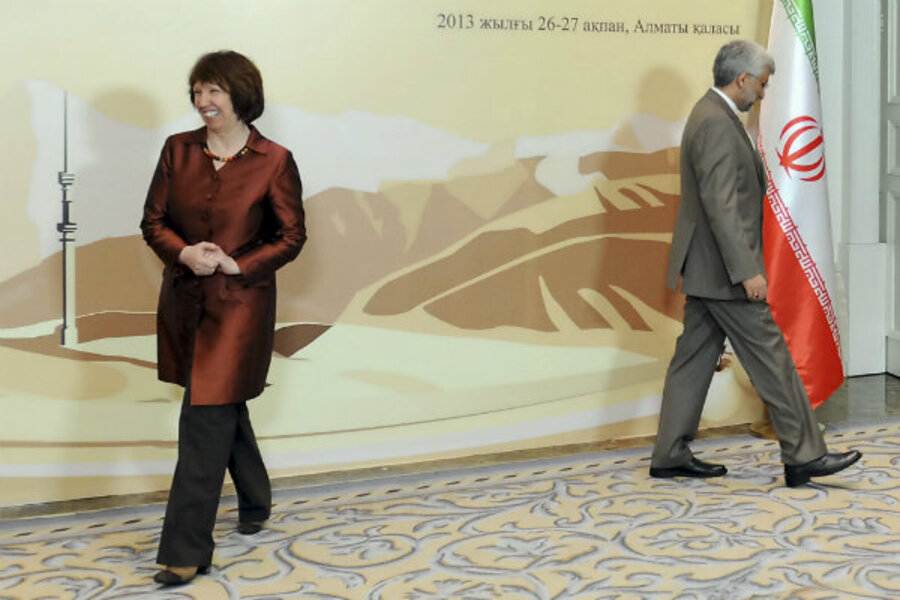What could finally topple Iran's regime? Earthquakes.
Loading...
| Tel Aviv
In the past half-century, earthquakes have directly contributed to the overthrow of at least two authoritarian regimes in Nicaragua and Iran. By exposing government corruption and incompetency, earthquakes wield the ability to inflict political damage to the world’s most ironclad regimes with a level of potency matched only by their unpredictability.
As EU foreign policy chief Catherine Ashton and Iran’s chief negotiator Saeed Jalili meet in Turkey today to continue working toward an agreement on Iran’s nuclear program, the Iranian leadership should heed history’s warning: No nuclear program can save a regime from a toppling earthquake.
In 1972, a powerful earthquake devastated Nicaragua’s capital, Managua, setting off a chain reaction of public discontent that eventually led to the ousting of the notoriously corrupt Somoza dynasty. For the Nicaraguan people, President Somoza’s squandering of international emergency aid following the earthquake was the last straw in a series of blatantly corrupt moves that showed little regard for their wellbeing.
The second instance occurred in September 1978 in Iran, when a 7.7 magnitude earthquake killed more than 26,000 near the eastern city of Tabas. The dismal response of the equally corrupt shah pushed Iran’s already bubbling popular uprising to a boiling point, one month after the CIA made its historically erroneous assessment that the country was “not in a revolutionary or even pre-revolutionary situation.”
As the Somozas and the shah can attest from their resting place in history’s dustbin, earthquakes are much more than nature’s most destructive physical force.
Since the ayatollahs took power in 1979, more than 78,000 Iranians have died in hundreds of powerful earthquakes. The vast majority of those killed were crushed by their own poorly constructed homes, with earthquakes flattening entire villages in Iran’s neglected and impoverished rural areas in several instances.
Although the entirety of Iran’s territory sits on one of the most seismically active areas in the world, it ranks far lower than countries like Japan, Chile, and Turkey in terms of average earthquake magnitude and frequency.
And yet, the scale in which seismic events translate into humanitarian and economic disasters in Iran is staggering. This is due primarily to the wanton mismanagement and underfunding of the government’s disaster relief programs and earthquake preparedness measures, which in other nations have a proven ability to save countless lives.
While Iran’s seismic reality cannot be altered, the region’s political and economic tectonic plates are shifting against the ayatollahs’ favor. The potential damage – both political and physical – of another powerful earthquake will only multiply as Iran’s economy deteriorates and the government’s budget buckles.
Currently an estimated 2 percent of the country’s expenditure is devoted to disaster relief. This amount will be further expected to dwindle under the weight of international sanctions, President Mahmoud Ahmadinejad’s irresponsible subsidy policies, and untold corruption throughout Iran’s ruling class. These factors have already caused tremors of public discontent among the middle class.
Several recent earthquakes have further shaken public confidence in the government. In August 2012, a 6.4 magnitude earthquake struck Iran’s rural northeastern provinces near the city of Tabriz, killing more than 350 and leaving 16,000 homeless. Local residents and response teams criticized the government’s delayed response, shortage of tents and medicine, and inability to reach many outlying villages altogether.
Mr. Ahmadinejad’s decision not to cancel a planned trip to Saudi Arabia three days after the Tabriz earthquake sparked outrage nationwide, while opening up the floor for infighting with his political opponents. Supreme Leader Ayatollah Khameini was also the subject of rare criticism, after he only offered his condolences 30 hours after the quake struck. State media was accused of outright ignoring the disaster, choosing instead to cover the ongoing Olympic games, comedy shows, and “Western plots” in Syria.
this year, on April 10, a 6.3 earthquake struck about 100 miles south of the Bushehr nuclear reactor. This was just four days after negotiations with the P5+1 world powers in Kazakhstan ended with an Iranian refusal of the most comprehensive incentives package offered by the West to date. The offer was conditional on Iran halting uranium enrichment.
The world was able to breathe a sigh of relief after it became apparent that the quake would not cause a Fukushima-replay in the oil-rich Persian Gulf, although its symbolism cannot be ignored. The quake had destroyed several dilapidated villages and killed dozens while the nearby reactor remained unharmed – essentially turning Bushehr into an icon of the government’s misplaced aspirations to become a nuclear power at the cost of its citizens’ wellbeing.
Six days later on April 16, an even more powerful 7.8 magnitude earthquake struck near the Iran-Pakistan border. Government officials initially claimed that the death toll would be “in the hundreds,” but damage to Iranian areas was ultimately minimal. While the government escaped another potentially embarrassing disaster, one can only imagine the repercussions had this earthquake had an epicenter in Tehran or Esfahan.
As they brace for the impact of particularly contentious presidential elections in June, Iran’s ayatollahs have made every effort to solidify their rule by portraying strength internally and defiance outwardly. Prospects for a solution to the nuclear issue have been decidedly pushed back until after the elections, while the Revolutionary Guard appears poised to swiftly crack down on any political mobilization in Tehran or elsewhere.
The Iranian regime may be confident in its ability to outmaneuver its political and military opponents, but it cannot defeat the powerful forces of nature beneath its feet. Whether it be armed conflict, economic prosperity, or natural disasters, history has shown that the legitimacy of any government rests primarily on its ability to provide security for its people.
Until Iran’s leadership heeds this reality, it may just be a few earthquakes away from crumbling.
Daniel Nisman is the Middle East section intelligence director at Max Security Solutions, a geo-political and security risk consulting firm.







